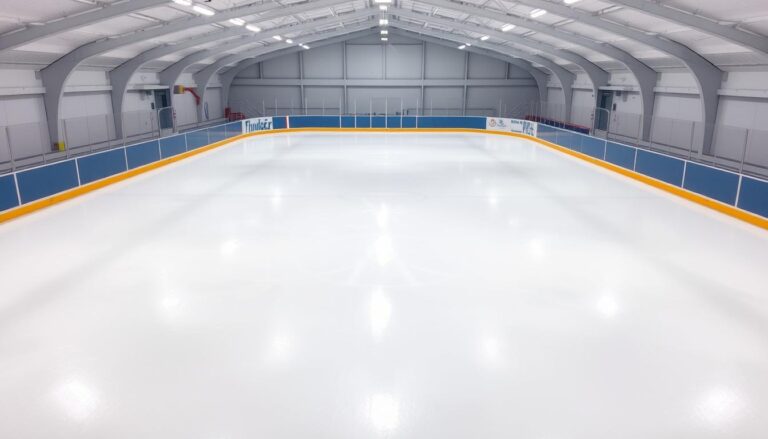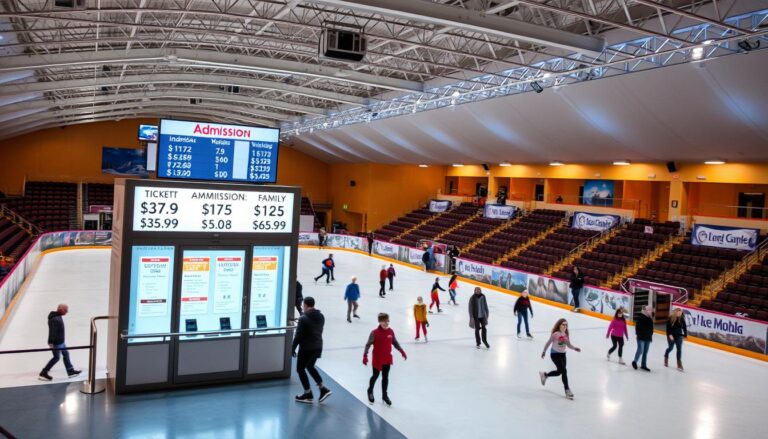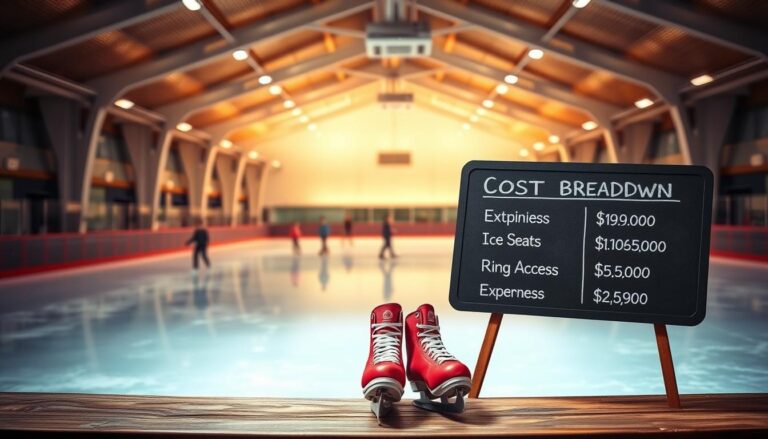How Cold Are Ice Skating Rinks? Find Out Now (Temperature Secrets Revealed)
Ever wondered about the exact temperature of ice skating rinks? Knowing the ice rink temperature is key for skaters and sports fans. It’s all about keeping the ice just right for a great skate.
Ice skating rinks usually stay between 24°F and 28°F (-4°C to -2°C). This range makes the ice solid but smooth for skating. Top venues spend a lot on keeping the ice perfect.
The ice’s temperature affects how well your skates work and how comfortable you feel. Top places use advanced cooling systems. These systems create a special environment for all skaters.
Professional ice rinks use high-tech to keep the ice at the right temperature. They use special cooling systems to keep the ice from melting. This ensures the ice is perfect for skating.
Different skating types need different temperatures. For example, figure skating and hockey need slightly different ice. This is why top venues adjust their ice temperature for each sport.
Recreational skaters might not know the science behind their fun. But, every degree of temperature changes the ice. This is why keeping the temperature just right is so important.
Learning about ice skating rink temperatures shows the mix of science, engineering, and sport. Next time you skate, think about the systems working hard to make the ice perfect for you.
Understanding Ice Rink Temperature Basics
Skating needs a precise scientific approach to create the perfect ice surface. The ice rink temperature is key to a great gliding experience. Knowing the science behind ice formation shows the balance needed for skating.
Ice formation is a cool process of molecular change. Water turns solid at certain temperatures, making a smooth surface for skaters. The best ice rink temperature is between 24-26 degrees Fahrenheit for the best skating.
The Science Behind Ice Formation
Water molecules change when cooled. They slow down and form crystals. This needs precise temperature control for the perfect skating surface.
- Molecular alignment occurs at 32°F (0°C)
- Optimal skating surface forms between 24-26°F (-4 to -3°C)
- Temperature impacts ice density and smoothness
Critical Temperature Thresholds
| Temperature Range | Ice Condition | Skating Performance |
|---|---|---|
| 32°F and above | Liquid water | Impossible to skate |
| 24-26°F | Optimal ice formation | Smooth, fast skating |
| Below 20°F | Overly hard ice | Reduced glide, more friction |
Surface vs. Air Temperature Differences
Skaters might be surprised to learn that ice rink temperature is more than air temperature. The surface temperature is different, needing special cooling systems for the perfect skating environment.
Professional rink managers always check and adjust temperatures for the best ice. The balance between surface and air temperature makes skating magical.
The Ideal Temperature Range for Ice Skating Rinks
Finding the right temperature for ice rinks is key for great skating. Both pros and hobbyists agree that temperature affects ice quality and how well you skate.
The best temperature for ice rinks is between 24°F and 28°F (-4°C to -2°C). This range is perfect for all kinds of skating. Each type needs a slightly different temperature:
- Figure skating: Prefer slightly warmer temperatures around 26°F
- Hockey: Perform best at cooler temperatures near 24°F
- Public skating: Maintained at a comfortable middle ground
Keeping the ice at the right temperature is a big job. It involves special cooling systems. Things like humidity, air temperature, and how many people are skating can change the ice.
Professional rinks use high-tech tools to keep the ice just right. Even a small change in temperature can make a big difference in how well you skate. So, keeping the temperature just so is very important.
Remember, the best temperature for ice rinks isn’t just about feeling comfortable. It’s about getting the best glide, less friction, and safe, fun skating.
| Skating Type | Ideal Temperature | Performance Impact |
|---|---|---|
| Figure Skating | 26°F | Smooth, precise movements |
| Hockey | 24°F | Fast, crisp skating |
| Public Skating | 25-26°F | Balanced, comfortable conditions |
Pro tip: Experienced skaters can feel subtle temperature differences that impact their performance on the ice.
How Cold Are Ice Skating Rinks: A Comprehensive Analysis
Walking onto an ice skating rink feels like stepping into a special climate zone. Knowing the exact temperatures needed for a smooth skating surface is key. This is important for both fun skaters and serious athletes. The climate of an ice skating rink greatly affects your skating experience.
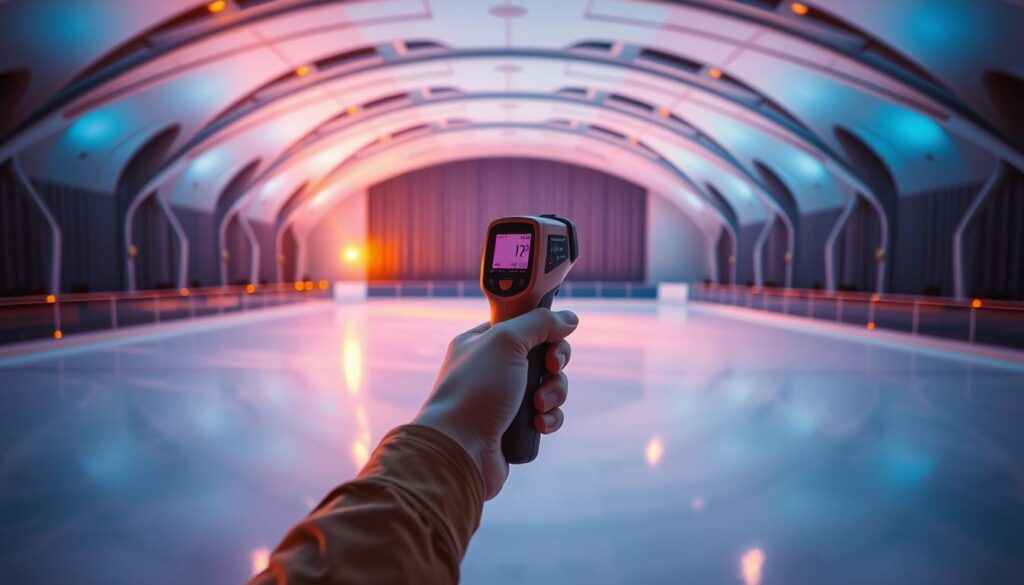
Now, let’s look at the temperature details that make ice skating rinks special places:
Surface Temperature Requirements
Ice skating rinks are usually kept between 24°F and 26°F (-4°C to -3°C). This range is perfect for:
- Creating solid ice
- Ensuring great skating conditions
- Reducing friction for smoother gliding
Ambient Air Temperature Standards
The air temperature around the ice also matters a lot. Most indoor rinks keep the air between 50°F and 65°F (10°C to 18°C). This helps prevent the ice from melting too much and keeps it strong.
| Rink Type | Surface Temp | Air Temp |
|---|---|---|
| Professional Hockey | 24°F | 55°F |
| Figure Skating | 25°F | 60°F |
| Recreational | 26°F | 65°F |
Temperature Variations by Rink Type
Different skating types need slight temperature changes. Professional hockey rinks are a bit colder for faster play. Figure skating rinks might be a little warmer for better edge control.
The climate of an ice skating rink is a mix of science and care. It makes sure every skater has a great time gliding on the ice.
Professional Ice Rink Cooling Systems Explained
The magic of a perfect ice skating surface comes from advanced cooling systems. These systems work hard to keep the ice just right. They are made up of many technological wonders that control the temperature.
Keeping the ice cool involves several key parts:
- Refrigeration pipes hidden under the ice
- Strong chiller units
- High-tech sensors to check the temperature
- Layers of insulation
Today’s ice rinks use glycol-based cooling systems. They have pipes under the ice that move refrigerant. This lets them quickly change the ice’s temperature to keep it perfect.
| Cooling System Component | Primary Function | Temperature Range |
|---|---|---|
| Refrigeration Pipes | Direct Cooling | 18-22°F |
| Chiller Units | Temperature Regulation | 15-25°F |
| Insulation Layer | Heat Prevention | Maintains Consistent Chill |
Ice rink managers spend a lot to keep the ice cool. They know that the right temperature is key for good skating and safety. The cooling system fights off heat from lights, people, and the air.
New technology lets managers watch and adjust the ice in real time. This means skaters always have the best ice, no matter what’s happening outside.
Temperature Management in Indoor vs. Outdoor Rinks
Ice skating rinks face special challenges in temperature control. Both indoor and outdoor rinks need careful management to keep the ice perfect. Skaters and rink managers know that temperature is key for a great skating experience.
Indoor and outdoor rinks need different ways to control temperature. Each setting has its own challenges for ice maintenance experts.
Indoor Climate Control Challenges
Indoor rinks have complex temperature issues. The closed space needs a balance of air temperature, humidity, and ice conditions. Rink managers must watch several important factors:
- Precise temperature regulation between 24-28°F
- Humidity control to prevent condensation
- Ventilation systems to manage air quality
- Consistent cooling techniques
Weather Impact on Outdoor Rinks
Outdoor rinks rely on natural weather. Temperature changes can greatly affect the ice and skating. Rink operators must quickly adjust to weather changes.
Seasonal Temperature Adjustments
Effective rink management needs a seasonal plan. Summer needs strong cooling, while winter has its own challenges. Professional rinks use advanced tech to keep the ice perfect all year.
Knowing about ice rink temperature control shows the science behind skating. It helps skaters appreciate the effort that goes into their favorite winter activity.
The Role of Humidity in Ice Rink Temperature Control

Humidity is key in keeping ice rinks cool. Many overlook its importance. Rink managers know that controlling moisture is as vital as cooling systems.
Too much humidity can ruin ice quality and skating. It’s essential to understand how humidity affects ice rink temperature.
The ideal humidity for ice rinks is between 40% and 50%. At these levels, keeping the ice cool is easier and more efficient.
- Low humidity prevents ice surface condensation
- Balanced moisture levels reduce frost formation
- Proper humidity control improves overall skating conditions
Modern ice rinks use advanced dehumidifiers with cooling systems. These technologies create the best skating conditions by managing air moisture.
| Humidity Level | Ice Rink Performance Impact |
|---|---|
| Below 30% | Ice becomes too dry and brittle |
| 40-50% | Optimal ice conditions |
| Above 60% | Surface becomes sticky and unpredictable |
Skaters notice changes in ice quality with humidity. A muggy day makes ice feel slow, while dry air makes it fast and responsive. Top venues spend a lot on precise humidity control for consistent skating.
Learning about ice rink temperature management shows the science behind perfect skating environments.
Impact of Temperature on Ice Quality and Skating Performance
Ice skating is a precise sport where temperature is key. The right temperature for ice rinks can greatly affect an athlete’s performance. It impacts speed and technique.
Professional athletes know that ice rink temperature is more than just comfort. It’s about creating the perfect skating surface. Small changes in temperature can make a big difference in how smooth or hard the ice is.
Professional Athletes’ Temperature Preferences
Different skating disciplines need different ice conditions. Competitive skaters aim for specific temperature ranges to improve their performance:
- Figure Skating: Prefer slightly warmer ice around 24-26°F
- Speed Skating: Require colder surfaces around 20-22°F
- Hockey: Typically maintain ice at 22-24°F
Ice Density and Temperature Correlation
Temperature affects ice density, which changes skating dynamics. Colder temperatures create harder, more compact ice that allows for faster glides and more precise movements.
| Temperature Range | Ice Characteristics | Performance Impact |
|---|---|---|
| 20-22°F | Hard, Dense Ice | Maximum Speed, Minimal Friction |
| 24-26°F | Softer, More Forgiving Surface | Better Grip, Enhanced Maneuverability |
Knowing these temperature details helps skaters adjust their techniques. They can choose the best skating conditions for their style and goals.
Energy Efficiency in Ice Rink Temperature Maintenance
Keeping ice rinks cool needs smart energy plans. Today’s ice skating rinks use new tech to save energy and stay cool. This tech makes sure they run well and are good for the planet.
Keeping ice perfect is a big challenge. It takes a lot of energy. But, rink owners are finding ways to use less energy and save money.
- Heat reclamation systems capture excess cooling energy
- Advanced insulation techniques reduce temperature fluctuations
- Smart monitoring controls optimize power usage
- Renewable energy integration offsets carbon footprint
Renewable energy is key for rinks today. Solar panels and geothermal systems help cool rinks without harming the environment.
Here are some ways to save energy:
- Use energy-saving LED lights
- Get high-efficiency refrigeration
- Make detailed plans for temperature control
- Keep cooling systems in top shape
New tech is changing how rinks use energy. By focusing on green practices, rinks can cut down on pollution. They can also keep their ice perfect.
Common Temperature-Related Issues in Ice Rinks
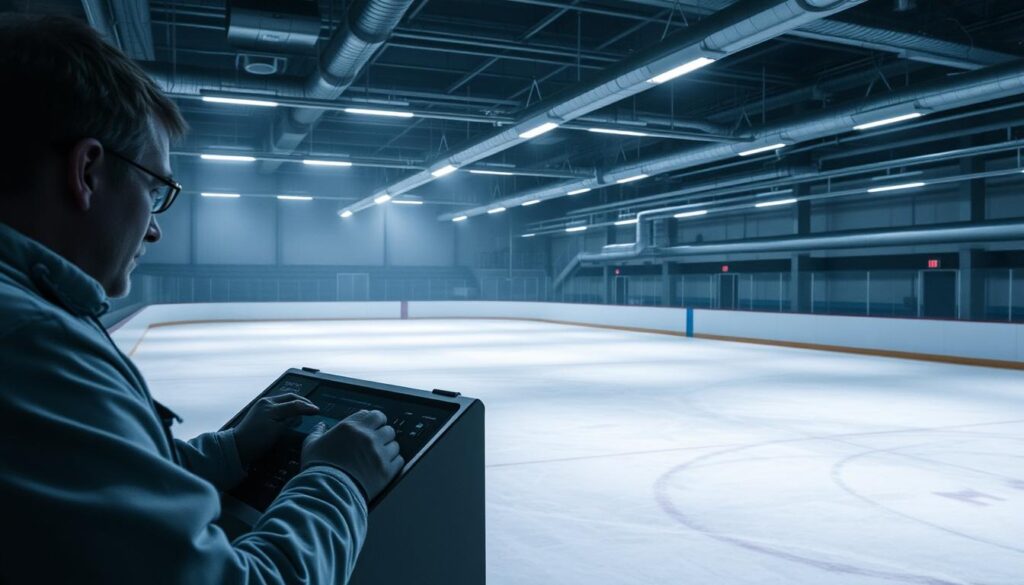
Keeping ice rinks at the right temperature is a big job. Skaters might not know how much work goes into it. It’s all about controlling the temperature to keep the ice perfect.
Identifying Common Temperature Problems
Ice rink managers deal with many temperature issues. These problems can make skating less fun:
- Soft Ice Surfaces: Too warm and the ice gets mushy
- Frost Buildup: Too much humidity can make the ice dangerous
- Uneven Ice Density: Changes in temperature make the ice uneven
- Condensation and Fog: Bad temperature control can make it hard to see
Troubleshooting Temperature Challenges
Experts use special tools to fix temperature problems. They watch the temperature closely to catch issues early.
Prevention Strategies
To keep the temperature right, rinks need to be proactive:
- Regular checks on cooling systems
- Keeping an eye on humidity
- Using the latest tech to track temperature
- Being ready to act fast when temperatures change
Skaters and rink managers can work together. This way, they can keep the ice perfect for everyone’s fun and safety.
Safety Considerations Related to Rink Temperature
Skating safety begins with knowing how cold ice skating rinks are. It’s also about managing the climate of the rink. The temperature is key to a safe place for all skaters.
The temperature of an ice skating rink affects safety. Too cold or too warm can be risky. Rink managers keep the ice at the right temperature for the best skating.
- Ideal rink temperatures are between 24-28 degrees Fahrenheit
- Ice gets too brittle if it’s below 20 degrees
- Temperatures over 32 degrees make the ice bad for skating
Skaters need to get ready for indoor ice rinks’ climate. Layered clothing helps keep warm and avoid injuries. Young and older skaters need extra care with temperature.
Important safety tips include:
- Wearing the right protective gear
- Knowing your own cold tolerance
- Spotting signs of hypothermia early
- Staying hydrated
- Dressing right for skating
Professional rinks use strict temperature checks to keep skating safe. Finding the right balance between good ice and comfort is a big job.
Your safety on the ice depends on knowing and respecting the rink’s climate. Stay informed, get ready, and have fun skating!
Modern Technology in Ice Rink Temperature Control
The world of ice skating rinks has changed a lot with new technology. Now, keeping the ice at the right temperature uses advanced systems. These systems are very precise and efficient.
Ice skating facilities are using smart tech to improve their cooling systems. These new solutions do more than just control temperature. They also let people monitor and control things in new ways.
Smart Temperature Monitoring Systems
Today’s ice rink cooling systems have smart sensors. These sensors track important data in real time. They watch things like:
- Precise surface temperature measurements
- Humidity levels
- Air circulation patterns
- Energy consumption metrics
Advanced Cooling Technologies
New cooling technologies for ice rinks are very exciting. They make the ice rinks more efficient and better to use.
| Technology | Key Benefits | Energy Efficiency |
|---|---|---|
| Zoned Cooling Systems | Customized temperature control | Up to 35% reduction |
| AI-Powered Climate Management | Predictive temperature adjustments | Up to 40% savings |
| Nano-Enhanced Cooling Surfaces | Improved heat dissipation | Up to 25% improvement |
These new technologies are a big step forward in cooling ice rinks. Precision engineering meets intelligent monitoring. This makes a better place for skaters and saves a lot of energy.
Now, rink owners can use data to keep the ice perfect. This means everyone can have a great time skating, thanks to the latest in temperature control.
Environmental Factors Affecting Ice Rink Temperature

Keeping the ice rink cool is more than just controlling the temperature. It’s about understanding how the environment affects it. This requires a deep knowledge of how different factors work together.
Several important factors affect the ice rink’s temperature and how well it performs:
- Outdoor temperature changes
- Humidity levels
- Body heat from people watching and skating
- Ventilation systems
- How well the building is insulated
Rink managers must always adjust to new environmental conditions. Changes in the climate can greatly impact the ice quality. So, keeping the temperature just right is key for a great skating experience.
Modern rinks use advanced cooling systems to handle these challenges:
- Geothermal cooling systems
- Reflective roof materials
- Advanced temperature monitoring tools
- Adaptive insulation methods
Outdoor rinks have even bigger challenges. Seasonal changes, sunlight, and wind can quickly ruin the ice. This means rink managers need to stay alert and find new ways to keep the ice good.
Today’s top facilities use smart climate control systems. These systems adjust cooling based on current environmental data. This keeps the ice quality consistent, saves energy, and cuts down on costs.
Seasonal Temperature Adjustments for Ice Rinks
Keeping the ice rink temperature just right is a big challenge that changes with the seasons. Skaters and rink managers must stay alert and use smart strategies to control the temperature.
Skating places need the right temperature all year. The effort to keep the ice perfect changes a lot from summer to winter.
Summer Operations Challenges
Summer is tough for ice rink temperature control. Heat and humidity can damage the ice. Managers must use special cooling methods to keep it right.
- Robust insulation systems protect against external temperature fluctuations
- Advanced refrigeration units work overtime to maintain consistent ice temperature
- Strategic scheduling of maintenance activities minimizes heat exposure
Winter Temperature Management
Winter also has its own challenges for ice rink temperature. Even when it’s cold outside, keeping the ice quality up is key.
- Precise dehumidification processes prevent moisture-related ice degradation
- Cooling system adjustments accommodate fluctuating external temperatures
- Regular ice thickness monitoring ensures optimal skating conditions
Rink operators must always adjust their temperature control plans to offer great skating all year. The art of ice rink temperature management is a delicate balance of science, technology, and expertise.
Cost Implications of Temperature Maintenance
Keeping the ice at the right temperature is very expensive. Rink managers have to make tough choices about money. These choices affect how much they spend now and in the future.
There are many costs to consider:
- Energy used for cooling
- Costs for fixing or replacing equipment
- Money needed for staff to control the temperature
- Insurance and other overhead costs
Modern ice rinks use the latest tech to control the temperature. Energy-efficient cooling systems can cut down on costs. Yet, they keep the ice perfect. Big arenas spend $50,000 to $150,000 a year on cooling.
| Facility Type | Annual Cooling Costs | Energy Efficiency Rating |
|---|---|---|
| Community Rinks | $30,000 – $75,000 | Moderate |
| Professional Arenas | $100,000 – $250,000 | High |
Climate change and higher energy prices are big problems for ice rinks. Spending wisely on cooling can save money in the long run. It also makes sure skaters have a great experience.
New ideas like smart temperature systems and green energy are helping. These ideas cut costs and help the environment too.
Conclusion
Understanding ice skating rink temperatures is more than just checking the numbers. It’s a mix of science, technology, and careful planning. Whether it’s a big sports arena or a small community center, the right temperature is key for a great skating experience.
Our journey showed us what makes ice skating work. It’s not just about keeping it cold. It’s about making sure it’s safe, fun, and perfect for performance. Cooling systems, controlling humidity, and monitoring technology all play a part in making the ice smooth and ready for skating.
Now, both skaters and rink managers know more about the science of ice. Whether you skate for fun or competitively, knowing about ice rink temperatures can make your time on the ice better. With new tech coming out, the future of skating looks even more exciting.
We encourage you to notice the temperature at the rink. Feel the difference in temperature and appreciate the engineering that makes skating possible. Share your experiences, ask questions, and keep exploring the world of ice skating temperatures.

